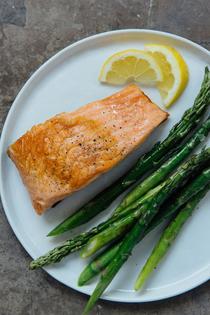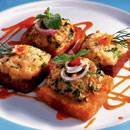The Kitchn: How to cook perfect salmon fillets
When it comes to simple, quick-cooking weeknight meals, salmon fillets always have a place in my regular lineup. This foolproof technique delivers a perfect medium-cooked fillet that's tender and flaky with deliciously crispy pan-seared skin.
Buying the salmon
When cooking salmon in the oven or on the grill, one large piece of fish works well. But when pan-searing on the stovetop, opt for individual fillets. One 6- to 8-ounce fillet per person is a good amount. And if you're buying multiple fillets, don't be afraid to ask your fishmonger to portion them for you.
The best pan for the job
While it's certainly not the only way, we prefer sticking with a large stainless steel or cast iron skillet when cooking pan-seared salmon; make sure it's a pan that's large and wide enough to accommodate the fillets without overcrowding. And because the best results happen when the fish is cooked on a super-hot surface, it's best to skip the nonstick cookware this time around.
Three rules for super-crispy skin
The very best thing about pan-seared salmon (in addition to a no-fuss process and super-quick cook time) is the skin. When cooked any other way, fish skin is, well, kind of unappetizing. But when a fillet is perfectly pan-seared, it's a totally different story. The skin cooks up to be super crispy; it's thin, brittle and savory, in a way that's kind of on par with really good potato chips or bacon. Follow these three rules and you'll be rewarded with perfectly crispy skin every time.
1. Always start with room-temperature fillets. Cold salmon fillets pulled straight from the fridge are not a friend of a screaming hot pan. When cold fish is added to a hot pan, the fillets will immediately seize up and are more likely to cook unevenly. Instead, remove the fish from the refrigerator about 15 to 20 minutes before you're ready to start cooking, in order to bring them up to room temperature.
2. Make sure the fillets are dry. Before adding the salmon fillets to the pan, use a paper towel or a clean dish towel to pat each one dry. When the fillets are moist or wet, they're more likely to stick to the pan, and the skin won't crispy quite as nicely.
3. Use a really hot pan. A hot pan and high heat don't necessarily go hand in hand. Keep the flame around medium to medium-high, but before anything touches the pan, let it get hot -- like, really hot. After, pour in a thin layer of oil and heat until it shimmers. Then add the fish and let it do its thing.
Start with the fillets skin-side down
While the salmon will cook on both sides, the process should always start by adding the fish to the pan skin-side down. The skin is tough and durable, and can withstand more time on the hot surface of the pan without overcooking.
Trust and the waiting game
This is arguably the hardest part of cooking pan-seared salmon. Once the fish hits the pan, the very best course of action is to step away (but not too far) and let it do its thing. It might take some serious willpower, but you need to trust the process -- no touching, no poking or prodding, and no moving the fillet around. You'll be tempted to lift the fish or move it around the pan to see how it's coming along, but the very best thing you can do is to keep your hands off and wait.
Let the visual cues guide you
When pan-searing, the bulk of the cooking takes place while the salmon is skin-side down. After it's been cooking for a few minutes, you'll start to notice the color of the fillet slowly begin to change. Starting from the bottom, where the skin touches the pan, and working its way upward along the sides of the fillets, you'll see the flesh lighten from deep, dark pink to a much more pale color.
This change in the color of the flesh will act as your indicator for how the cooking process is progressing. Once the color change has moved up about three-quarters of the way from the bottom, it's time to flip. Since the bulk of cooking has already happened, the salmon will cook for a couple minutes more after flipping it flesh-side down. What you'll get is a tender and flaky piece of salmon, cooked perfectly to medium, with super-crispy skin.
Pan-Seared Salmon Fillets
Makes 2 fillets
Ingredients
2 (6-ounce) salmon fillets
1 tablespoon canola or vegetable oil
Salt
Equipment
Paper towels or dish towel
Skillet or frying pan
Measuring spoon
Fish spatula
Medium plate
1. Remove the salmon fillets from the refrigerator about 15 minutes before you're ready to cook (this will give them enough time to come to room temperature).
2. Use a paper towel or clean dish towel to pat each fillet dry, both on top and bottom, to prevent them from sticking to the pan.
3. Place a stainless steel or cast iron skillet on the stovetop over medium-high heat, and let the pan heat up for a couple minutes.
4. Flick a few drops of water into the pan to test if it's hot enough. If the water sizzles and evaporates almost immediately, the pan is ready to go. If not, let it heat up for another minute and test again.
5. Once the pan is hot enough, add 1 tablespoon of canola or vegetable oil to the pan. Tilt the skillet so that a thin layer of oil coats the bottom. Continue to heat the oil until you see ripples across the surface, but not long enough that it smokes.
6. Just before adding the salmon to the skillet, season the fillets with salt.
7. Carefully add the fillets to the skillet one at a time, skin-side down.
8. The majority of the cooking will take place while the salmon is skin-side down in the pan. Above all else, resist the temptation to poke, prod or move the fish; it's important that you leave it be. As the fish cooks, you'll notice the color of fillet begin to lighten, starting at the bottom near the skin and slowly moving upwards. Cook the salmon, without touching it, until the lighter-colored flesh has moved about 3/4 of the way up the fillets, for about 4 minutes for 1/2 inch of thickness, approximately a total time of 8 to 9 minutes for thick fillets and 6 to 7 minutes for thinner fillets.
9. Use a fish spatula to flip the salmon fillets, turning the fish away from you to prevent any oil splatter. Cook for an additional 2 minutes for thicker fillets and 1 to 2 minutes for thinner fillets.
10. Use a fish spatula to remove the fillets from the pan, and transfer them to a paper towel-lined plate, placing the salmon skin-side down.
11. Rest the fillets for about 3 minutes before serving.
(Kelli Foster is an assistant food editor for TheKitchn.com, a nationally known blog for people who love food and home cooking. Submit any comments or questions to editorial@thekitchn.com.)











Comments